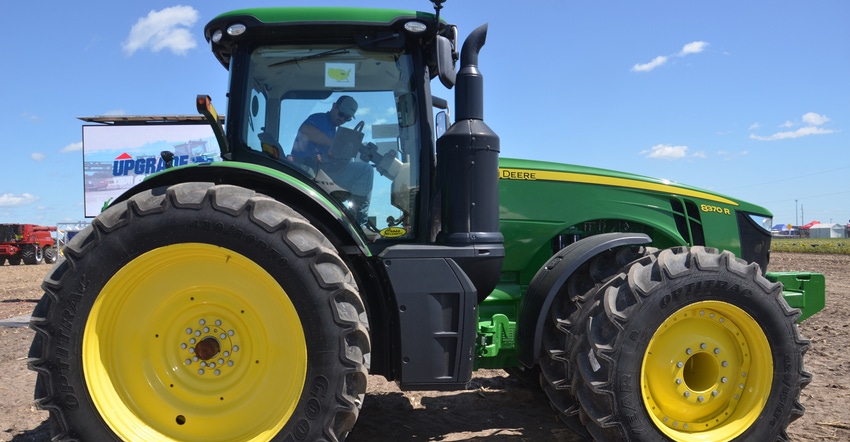
You’re ready to buy new tractor tires. Your dealer talks about bias versus radial tires, VF, IF and CFO. Is he speaking a foreign language? All you want to do is buy tires!
Two industry experts help sort through the jargon. They are Scott Sloan, ag products manager for Titan and Goodyear farm tires; and Brad Harris, manager of global field engineering for Firestone Ag.
Here is a “dictionary” of tire terms, followed by some explanation from these experts:
Bias ply: This is older tire technology.
Harris: This tire construction features body plies that are placed on a diagonal to the bead. The body plies crisscross in the sidewall and tread which provides strength to contain the inflation pressure and defines the tire shape. Bias tires have limited sidewall deflection and are stiffer than a radial tire.
Sloan: The design gives it extra stiffness and penetration resistance, but also means a rougher ride and generally a shorter life span than radials. However, they’re typically less expensive than radials.
Radial tires: This technology has been available for ag tires for over a decade.
Harris: This tire construction features body plies that are perpendicular to the bead, and belts in the tread area that are placed on a diagonal. The body plies provide the total width of the tire and run perpendicular to the beads to allow the tire to deflect or flex when in operation. The belts define the tire diameter and the footprint shape. Combining the flexible body plies and tread belts allows a radial tire to develop a long footprint and generates more traction versus a bias tire.
Sloan: This construction is generally more durable and longer lasting than bias tires, but also more expensive. For larger field production, radials are becoming the industry standard, whereas bias is still common in smaller sizes.
Ply rating: This was the standard system for decades.
Harris: This is an old system of classifying bias tires based on the number of body plies based on the strength of the cotton fabric used as body plies. As tires have moved to stronger body ply materials, the ply rating of a tire doesn’t represent the number of body plies in the tire.
Load index: This is an important measure of the load a tire can carry today.
Harris: It’s a number that indicates the rated load of a tire. This value has replaced the ply rating because it provides the load of the tire in pounds and kilograms. The load index chart is a global standard and used to define the load rating of all types of tires.
IF tire: The letters stand for increased flexion.
Harris: An IF tire is a radial agriculture tire that is designed to carry 20% more load, will have more sidewall deflection and a larger footprint compared to a standard radial at the same inflation pressure. The larger footprint allows for more traction.
Sloan: You can also carry the same load at 20% lower inflation pressure. By running at lower inflation pressure, you can help reduce soil compaction. However, IF technology is only effective if inflation pressure is adequately maintained by application and weight.
VF tire: The letters stand for very high flexion.
Harris: A VF tire is a radial agriculture tire that is designed to carry 40% more load. It will have more sidewall deflection and a larger footprint compared to a standard radial at the same inflation pressure. The larger footprint allows for more traction.
Sloan: VF tires can also carry the same load as standard tires at approximately 40% lower inflation pressures. Just as with IF tires, you can help reduce soil compaction. And just like IF tires, VF technology is only effective if inflation pressure is adequately maintained by application and weight. For both IF and VF tires, increased flex can cause problems with road lope, power hop and general ride quality if inflation isn’t maintained.
CFO designation: CFO stands for cyclic field operation. Expect to find this on combine or grain cart tires.
Harris: Cyclic field operation describes the loading experienced by combines and grain carts — sometimes full, sometimes empty. IF or VF radial tires approved for this type of equipment will be marked with the CFO suffix.
Sloan: CFO tires can handle loads 55% heavier than IF load ratings when traveling less than 10 miles per hour in a cyclic application. Additionally, CFO gets a 30% load bonus from IF load for cycling applications under 20 mph.
Advanced Deflection Design technology: This is also known as AD2 technology, and it’s from Firestone.
Harris: This design lets producers carry the same load, or as much as 20% on IF tires or 40% on VF tires more load, as a standard radial tire, but at a lower tire pressure, offering a smoother ride.
LSW: The letters stand for Low Sidewall Technology. It’s exclusive to Goodyear.
Sloan: LSW tires feature a larger rim diameter than standard tires, while maintaining the same outside diameter of tire. LSW tires meet all the same load and inflation capabilities as VF and CFO tires, meaning they can also help reduce soil compaction. They also help eliminate ride quality problems such as road lope and power hop. This helps with transport speeds and with getting the seed in the ground in high-drawbar planting applications that could be disrupted by power hop.
About the Author(s)
You May Also Like




